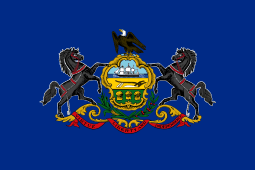Pennsbury Manor
|
Pennsbury Manor | |
|
Pennsbury Manor. October 2012. | |
  | |
| Nearest city | Tullytown, Pennsylvania |
|---|---|
| Coordinates | 40°07′58″N 74°46′06″W / 40.13278°N 74.76833°WCoordinates: 40°07′58″N 74°46′06″W / 40.13278°N 74.76833°W |
| Built |
Original: 1683 Recreation: 1939 |
| Architect |
Original: Unknown Recreation: R. Brognard Okie |
| NRHP Reference # | 69000154[1] |
| Significant dates | |
| Added to NRHP | October 28, 1969 |
| Designated PHMC | November 11, 1949 and October 08, 1951[2] |
Pennsbury Manor is a recreated colonial estate in Falls Township, Bucks County, Pennsylvania. From 1683 to 1701, it was the American home of William Penn, founder and proprietor of the Colony of Pennsylvania. The estate and its buildings were recreated in the 1930s. The property was placed on the National Register of Historic Places on October 28, 1969. The manor house and grounds are administered by the Pennsylvania Historical and Museum Commission in association with The Pennsbury Society, and are open to the public.[3]
History
William Penn (1644-1718) of England, the new Proprietor of the King's Grant for the Province of Pennsylvania, traveled to the New World of "The Americas" in 1682 to start his dream of a "Holy Experiment" free from religious persecution for his "Religious Society of Friends" ("Quakers"). With a 26-million-acre (110,000 km2) tract granted by the English King, Charles II (1630-1685), his dream became a reality. He met with the local Native American tribes to negotiate fairly and sue for peace and obtain their blessing (and even cooperation) to settle the land, resulting in success. Penn then plotted out the village of the future great City of Philadelphia between the Delaware (running towards the north and northeast) and the Schuylkill Rivers (smaller tributary running to the northwest). His focus then turned to platting and building a manor house for him and his family.
The original manor was located along the banks of the Delaware River, between the river proper and future-named Van Sciver Lake. Construction at what came to be called "Pennsbury" was begun soon after Penn's arrival in the Colony in 1682 and completed in about 1686. In addition to the central manor house, there were separate buildings for baking and brewing, a large stable, a boathouse, and numerous farm buildings. Penn's plan was to establish the sort of gentleman's country estate similar to that which had been his home in England.
Penn spent most of his time in the central and soon-to-be capital city of Philadelphia governing his settlement, leaving the house empty for long periods of time. The house had already fallen into disrepair by 1736, a half-century later, when one of Penn's sons remarked that the house "was very near falling, the roof open as well as the windows and the woodwork almost rotten." However, the old manor house remained in the Penn proprietary family until 1792.[4]
The Warner Company of Philadelphia, established in 1794, operated as a firm dealing in sand, gravel and other construction materials. At some time, they acquired the deserted land where William Penn's "Pennsbury Manor" once stood. On Sunday, October 23, 1932, the 250th anniversary of Penn's arrival, a touching and significant ceremony was held at Pennsbury. Charles Warner, President of the Warner Company, presented the deed for nine and eight-tenths acres, the portion on which the buildings had stood, to the Commonwealth of Pennsylvania to this tract of land on the river north of Philadelphia as a permanent memorial site to the Quaker statesman and benefactor of mankind. The Pennsylvania Historical Commission assumed the responsibility for that which then became known as The Pennsbury Memorial as the manor was not yet envisioned. The exact location of the original manor house was on this property was not to be rediscovered for many decades.[5]
Along with "Pennsbury Manor", Penn also rented "The Slate Roof House" in Philadelphia as his second residence and city townhouse in the colony during the period 1699 to 1701.
Exterior
The recreated red-brick manor house stands two stories tall with dormer windows piercing the hipped roof on the third level for an attic. It is designed in the "Georgian" style of architecture and stands five bays wide and two piles deep. The white wooden window with the door and frame trim contrast against the red brick, which is laid in Flemish bond pattern. The manor house is surrounded by the support buildings, built in either matching red brick or whitewashed wood frames. Pennsbury Manor was designed by local architect R. Brognard Okie, (1875-1945), who also restored the Betsy Ross House in Philadelphia.
References
- ↑ National Park Service (2007-01-23). "National Register Information System". National Register of Historic Places. National Park Service.
- ↑ "PHMC Historical Markers". Historical Marker Database. Pennsylvania Historical & Museum Commission. Retrieved December 19, 2013.
- ↑ Pennsbury Manor official website
- ↑ P. L. Hudson, Pennsbury Manor: The Philosopher’s Garden, Pennsylvania Heritage Magazine, Number 4, Fall 1994.
- ↑ http://freepages.genealogy.rootsweb.ancestry.com/~wynkoop/webdocs/warnerfn.htm
External links
| Wikimedia Commons has media related to Pennsbury Manor. |
Further reading
- Seitz, Ruth Hoover & Blair; Pennsylvania's Historic Places; Good Books; Intercourse, Pennsylvania; ISBN 1-56148-242-0


